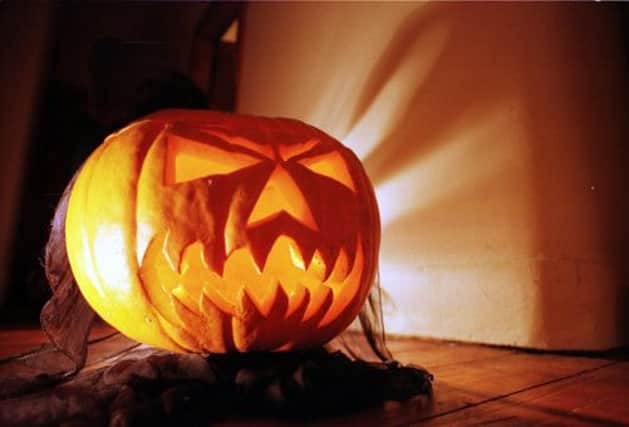Lori Anderson: Grown-ups grasp Hallowe’en spirit


Hallowe’en is currently as hot as Hell and Edinburgh is fanning the flames. Salem in Massachusetts, with its historical coven of witches, is the place to be in America if one wishes to feel a chill ripple down one’s spine but in Britain it is hard to resist the spell cast by the ghost tours of the South Bridge Vaults, the Covenanter’s Prison in Greyfriar’s graveyard and the Black Mausoleum, lair of the Mackenzie poltergeist.
Tonight hundreds will flinch in fear as they traverse these “haunted” quarters, while thousands more will gather along the Royal Mile to watch the finale of Samhain, when the Summer King, drunk on the fruits of autumn, is slain by the Winter King, signifying the annual triumph of darkness over light.
Advertisement
Hide AdAdvertisement
Hide AdFor what was once a night of sweeties and scares for children has been rediscovered by their parents and other adults as a celebration of exuberant excess and the opportunity to dress up as a slutty mushroom. In 2001 just £12 million was spent by the British public on costumes, pumpkins and ghoulish sweets. A dozen years later the figure is expected to be £325m, a rise of over 30 per cent on the previous year alone. Hallowe’en is now the third largest retail season after Christmas and Easter and has easily surpassed Guy Fawkes night in terms of financial worth and popularity.
Sophie Carroll, associate analyst at Planet Retail, said in a recent report: “This rise reflects a more favourable economic climate, as well as an increased Hallowe’en focus on the part of retailers, with competitive in-store prices on associated products and accessories. Though now established as a significant UK retail season in its own right, the British passion for Hallowe’en remains fuelled by US cultural influences, with the popularity of TV shows such as The Walking Dead and the Twilight movie franchise inspiring interest in the festival from across all ages.”
In a strange twist Hallowe’en is coming home from America. The origins of Hallowe’en are as twisty and sinister as a swirling witches brew with all manner of historical ingredients plopped into the bubbling cauldron. While ducking for apples was practised in Ancient Rome during celebrations for the festival of Pomona, the goddess of fruit, the majority of the modern elements of Hallowe’en flow from the ancient Celtic festival of Samhain, held on 31 October to mark the end of summer. Costumes are thought to have originated with the druids who wore animal skins to acquire their strength.
During Samhain, the veil between the living and the dead is translucent with the dead able to come back to visit. Spirits were placated with feasts and in some villages, people would dress as ghosts, dine on the prepared food, then process to the outskirts of the village in a bid to lead the ghosts away. “Trick or treat” is a faint echo of when our ancestors paid off ghouls for fear of what malevolent spells they might cast upon us.
Samhain was transformed over the centuries into Hallowe’en by the rise of Christianity and the dominance of the Catholic Church which had a habit of co-opting ancient rituals to its own end. From the 8th century AD Christians were expected to mark three Holy Days from 31 October to 2 November, which were All Hallows’ Eve, All Saint’s Day and All Soul’s Day, each designed to remember the dead, martyrs and saints (hallows is the old English word for saint.)
Costumes again came into play, with claims that villages too poor to own the relics of saints had locals dress up as patron saints and process to the church yards, while others dressed as angels and devils.
Ireland has, in many ways, helped spawn the modern Hallowe’en by exporting the celebrations to America in the 1840s and 1850s, when hundreds of thousands fled west to escape the potato famine and grinding poverty. What began with celebrations in small Irish communities slowly spread out across the nation during the 20th century. The modern pumpkin with its flickering eyes is an indigenous adaptation of the turnip used by the Irishman Jack o’ Lantern, who, according to legend, was a drunk so unpopular that neither God nor the Devil wanted him and when he was banished from Hell the devil hurled a hot coal which landed inside the turnip on which he was munching.
As pumpkins were plentiful in America, easier to carve, larger than turnips and offered a more sinister glow when lit, they soon became the symbol of the season and pulsed with a dark malevolence in the opening credits of John Carpenter’s classic seventies horror movie, Hallowe’en.
Advertisement
Hide AdAdvertisement
Hide AdThe trigger for the transformation of Hallowe’en from a children’s festival, in which those with kids lead them door to door in search of a sugar high and those who don’t quietly turn off the lights and slump down on the sofa pretending not to be home and the adult carnival it is becoming today, is the internet and America’s cultural influence.
The growth of Hallowe’en for adults in Britain has been fuelled by photographs and footage of the Hollywood parties held each year by celebrities. The reason Americans celebrate Hallowe’en so exuberantly is that with only ten days’ holiday each year, compared to 25 days in Britain, they do tend to embrace every opportunity for fun and celebration.
Strangely, a Hallowe’en costume is a better fit on an adult than a child, and so this cultural shift is to be welcomed. Children have the opportunity to dress up and play “let’s pretend” every day, a pleasure withdrawn from adults who would all benefit from a day pass, or to be more precise, a night off from themselves. A Hallowe’en costume party offers, for a few brief hours, a liberation from the tyranny of you and glimpse of the possibility of “what if?”